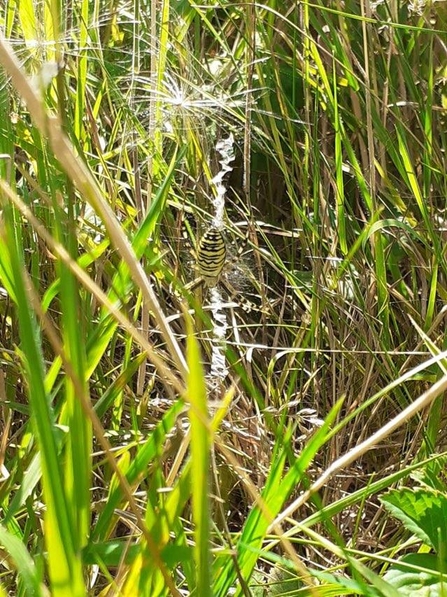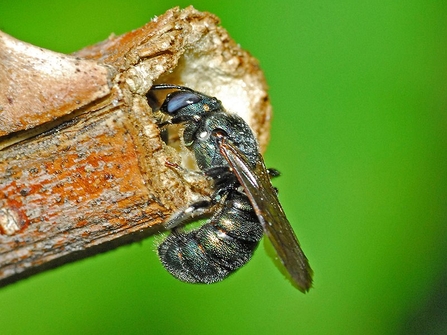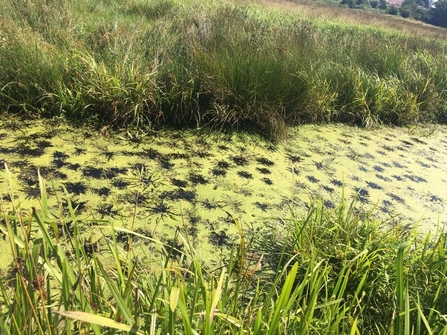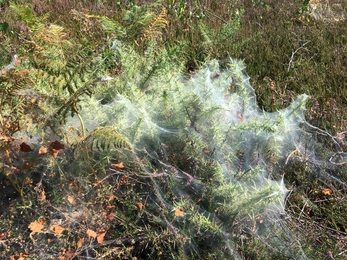Weekly wild news from our reserves, 14 August 2020
Grass snake by Jamie Hall
Charlie McMurray, our Sizewell Warden, spotted a dramatic moment when a grass snake caught and carried off a toad at our Sizewell Belts reserve. It was very hard to capture on the phone, but you can just about make out the snake's head as it makes its getaway.
The UK’s largest snake, grass snakes hunt amphibians, fish, small mammals and birds. When the snakes are themselves feeling threatened, they can ‘play dead’ and secrete a foul-smelling substance to deter predators. Grass snakes are declining in the UK and are classed as a UK Priority species for conservation action.
Grass snake makes its getaway after catching a toad - Charlie McMurray
Wasp spider and web
Female wasp spiders have evolved to mimic the markings of a wasp to deter predators. The males are harder to recognise, being smaller and pale brown. These large spiders build orb webs in grassland or heathland. The webs have a wide, white zig-zag strip running down the middle, known as a 'stabilimentum'. This beautiful female was found hanging in wait at Sizewell Belts this week.

Wasp spider - Charlie McMurray
Rare carpenter bee found at Arger Fen
A rare carpenter bee Ceratina cyanea has been recorded at Arger Fen & Spouse’s Vale. These small bees are usually only found in southern England and this is only the third time the species has been recorded in Suffolk recently, with a record from Needham Market in 1996 being the most northerly record in the UK.
These bees are so-called as the female burrows into the pith of dead woody stems such as bramble or dog rose to create nest cells for her young. She then collects pollen and nectar from flowers such as buttercup and yellow dandelion-like flowers to feed the larvae. The bees also use the hollowed-out stems as a hibernaculum from late summer onwards; often several individuals will hibernate together until spring.
Under a hand lens the bees appear dark metallic blue-black colour, with the male having an ivory white patch on its face.

Carpenter bee, Ceratina cyanea by Hectonichus
Complex communal webs
Our Meadows and Heath Warden Ben Calvesbert spotted this gorse bush covered with tent like spider webs created by the gorse spider mite this week.
Gorse spider mites live together in colonies living under a complex communal web they create out of spun silk that stretches from branch to branch of the gorse. Adults are only approximately a millimetre long and are bright red in colour but they are most easily identified by their webs rather than the species themselves. Females will lay up to four eggs a day during her relatively short life span of four weeks and her young are so small they are often dispersed by wind, whilst others remain and contribute to the colony they were born into.
Monitoring a rare spider
Our Broads Warden, Ellen Shailes, has been surveying the marshes for fen raft spiders this week. Found only in a very few locations in the UK with Carlton and Castle Marshes and Redgrave & Lopham fen being two such locations, the fen raft spider is a rare and protected spider and is a priority species for conservation action. Monitoring numbers allows Suffolk Wildlife Trust to assess how populations are faring on our reserves. So far, it's looking to be a good year for them at Carlton and Castle Marshes.

Surveying for fen raft spiders - Ellen Shailes
Toadlet translocation
The meadow cutting season is upon us and our teams across the county are working hard to maintain our reserves. A regime of annual hay cutting helps to maintain floral diversity from year to year and reduces the chance for single species to dominate.
Gunton Meadows is part of a small network of wildlife rich habitats in Lowestoft and the meadow habitats are important for a variety of different grassland species. This site was previously neglected for years until Suffolk Wildlife Trust took over the management of the site and has worked hard over the years to reinstate this area as a wildlife-rich site.
This week our Wardens safely removed toadlets that were hiding out in the grass before cutting Gunton Meadow.





